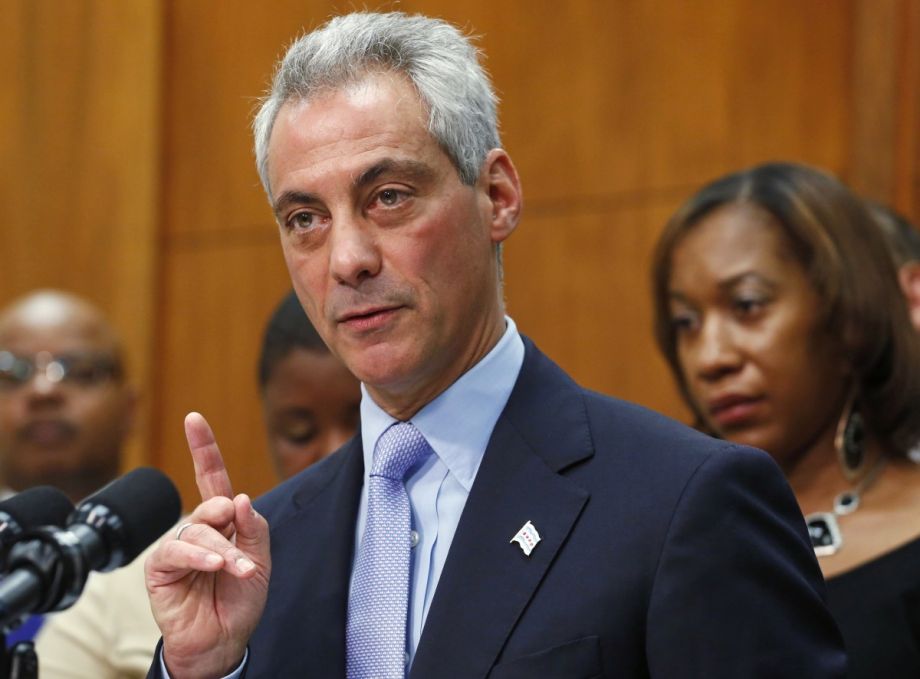Old Rail Transit Sparks New Thinking in Chicago

Mayor Rahm Emanuel has concluded that Chicago’s 2013 transit-oriented development ordinance doesn’t go far enough. (AP Photo/M. Spencer Green)
Our weekly “New Starts” roundup of new and newsworthy transportation projects worldwide.
Chicago Doubles Down on TOD
One reason cities across the country are pursuing new rail transit projects is because they are seen as tools to reshape the urban landscape. Rail transit especially, advocates argue, allows cities to promote dense, walkable development around station nodes, reducing the need for residents to drive wherever they go and promoting other desirable goals such as lower carbon emissions and more exercise.
One reason cities across the country are pursuing new rail transit projects is because they are seen as tools to reshape the urban landscape. Rail transit especially, advocates argue, allows cities to promote dense, walkable development around station nodes, reducing the need for residents to drive wherever they go and promoting other desirable goals such as lower carbon emissions and more exercise.
But what about cities that already have rail transit systems in place? Sometimes the local zoning code works against this sort of redevelopment. The city of Chicago realized this two years ago and rewrote its zoning ordinance to increase the allowable density and dramatically reduce parking requirements for developments located in zones around Chicago Transit Authority rapid transit stations and Metra regional rail stations.
Mayor Rahm Emanuel has concluded that the city’s 2013 transit-oriented development(TOD) ordinance doesn’t go far enough. A new proposed TOD ordinance would nearly triple the amount of land in the city where denser development would be allowed and increase the land subject to reduced parking requirements tenfold.

The Metropolitan Planning Council’s online TODcalculator lets users “explore the benefits of new development near transit.” (Credit: Metropolitan Planning Council)
Urban policy analyst and Metropolitan Planning Council project manager Yonah Freemark, writing on the MPC’s “The Connector” blog, notes that the proposed ordinance achieves many of the goals of the council’s “Grow Chicago” campaign. An MPC analysis of the proposed ordinance projects that over the next 20 years, the city could see 60,000 to 70,000 new housing units within a half-mile of rail transit stations, 50 percent more than currently allowed; 1,300 new affordable housing units and an additional $150 million for the city’s Affordable Housing Fund; $450 million in new annual sales for neighborhood businesses; and nearly $200 million in new annual tax revenues for the city and various public agencies.
“MPC hails this proposed zoning ordinance as an important step forward in growing our city toward its transit system,” Freemark writes. “We are excited to work with Mayor Rahm Emanuel, residents, businesses and community groups to encourage the passage of this ordinance, which we see as the first step toward a truly transit-oriented Chicago.”
New York Brings Its Subway Up to Date, Slowly
The New York City subway system is now 111 years old, and its last major system expansion took place almost 75 years ago. While several smaller additions have taken place since, and a long-needed subway line is finally being built now, this sprawling system continues to ferry millions using technology that became obsolete decades ago.
The New York City subway system is now 111 years old, and its last major system expansion took place almost 75 years ago. While several smaller additions have taken place since, and a long-needed subway line is finally being built now, this sprawling system continues to ferry millions using technology that became obsolete decades ago.
MTA New York City Transit is currently in the midst of a multi-year, multi-billion-dollar project to install state-of-the-art train control systems on all of its lines, working one line at a time. The L train, which connects Brooklyn’s Canarsie section with lower Manhattan, was the first to be equipped with the new technology, called “communications-based train control” (CBTC), and work is now under way on equipping the 7 line from Times Square (and soon Hudson Yards) to Flushing, Queens, with the technology.
Where the technology currently in use on the New York subway relies on manually operated mechanical switches and electrical relays dating to the 1930s to control train movements, the new system relies on trains “talking” to control centers and one another to maintain even spacing between trains. This technology increases capacity on the subway lines by allowing trains to run closer to each other and thus will allow the MTA to meet growing rider demand in reviving outer-borough neighborhoods as well as Manhattan itself.
How does this technology work, and what is it replacing? The MTA has produced an informative video showing today’s creaky technology and what’s to come. Fans of the movie The Taking of Pelham One Two Three may experience a sense of deja vu as the video’s first scenes play out. Take a look.
Private Firm Seeks to Build Minnesota HSR Line
In a move that has caught critics of the project by surprise, a private company is asking the Minnesota Department of Transportation for the exclusive right to lease air rights over a series of state highways in order to build an elevated high-speed rail line connecting Rochester with suburban Minneapolis using Chinese technology.
In a move that has caught critics of the project by surprise, a private company is asking the Minnesota Department of Transportation for the exclusive right to lease air rights over a series of state highways in order to build an elevated high-speed rail line connecting Rochester with suburban Minneapolis using Chinese technology.
The Rochester Post-Bulletin reports that the North American High Speed Rail Group is seeking the exclusive right to lease the highway air space from MnDOT for two years. The company says the exclusivity agreement is needed in order for it to determine the project’s feasibility and line up private investors.
The corridor in which the company seeks to build the line closely follows MnDOT’s proposed “Zip Rail” high-speed line between Minneapolis and Rochester, but would employ dramatically different technology, and the company says that if it determines it could build a privately financed line, it would change its name.
The company estimates it would cost $4.2 billion to build the line. One-third of that cost — $1.4 billion — would come from Chinese investors, and North American High Speed Rail Group’s chairman, Joseph Wang, formerly worked for China’s Ministry of Commerce.
Company spokeswoman Wendy Mealey said that while China offers the most advanced HSR technology, other technologies are being considered. “High-speed rail is a technology (the Chinese) are looking to export, so there is an opportunity there to explore with them. We’ve talked to a handful of European countries as well. Our vision is to take whatever foreign technology expertise and Americanize it and create a brand-new set of intellectual property,” she told the Post-Bulletin.
If built, the line would cover the 84 miles between Rochester and Bloomington in as little as 29 minutes using trains running at speeds up to 260 miles an hour. A Republican legislator quoted in the story decried what he called covert behavior by government, but a Democratic-Farmer-Labor representative said she was willing to let the company give it its best shot.
Know of a project that should be featured in this column? Send a Tweet with links to @MarketStEl using the hashtag #newstarts.
The Works is made possible with the support of the Surdna Foundation.

Philadelphia freelance writer Sandy Smith runs the Philly Living Blog for Noah Ostroff & Associates, a Philadelphia real estate brokerage. A veteran journalist with nearly 40 years’ experience, Smith writes extensively on transportation, development and urban issues for several media outlets, including Philadelphia magazine online.




No comments:
Post a Comment
Please leave a comment-- or suggestions, particularly of topics and places you'd like to see covered